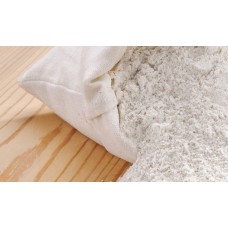Details
3 LBS = 1360 GRAMS
To Produce Sodium Hydroxide in Paper Industry
Calcium oxide is used to produce sodium hydroxide from sodium carbonate in chemical recovery at Kraft pulp mill. (Read also Inorganic Water Pollutants)
As Plaster
There is archaeological evidence that Neolithic B Pre-Pottery (pottery sticks) uses lime-based plaster for flooring and other uses. The ash-lime floor remained in use until the late of nineteenth century. (Read Chemicals in Joint Compound)
Chemical or Power Production
Solid spray or calcium oxide pulp can be used to remove sulfur dioxide from the exhaust flow in a process called flue gas desulfurization.
Shrimp Culture Industry
In the industry of shrimp or tiger shrimp culture, lime is popularly used as an alkaline substance to anticipate the decline in pH of pond water due to rain. Usually Tohor lime is sown on the edge of the shrimp pond in the rainy season.
As Weapon
Historian and philosopher David Hume, in his book on English history, recounts that in the early of the reign of Henry III, the British Navy destroyed the French fleet by blinding enemy fleets with chalk.
Raw chalk is also considered to be a component of the Greek fire. At its contact with water, lime will increase its temperature above 150 ° C and ignite the fuel.
Cautions of Calcium Oxide
Those all the uses of calcium oxide in our daily life. Things that we should consider are :
Due to the overwhelming reaction of lime with water, lime causes severe irritation when inhaled or in contact with moist skin or eye. Inhaling this substance can cause coughing, sneezing, shortness of breath. It can then develop into burn scar with perforation of the nasal septum, abdominal pain, nausea and vomiting.
Although lime is not considered a fire hazard, however its reaction with water can release enough heat to ignite the flammable material.
CHEMICAL HAZARD REACTION IN CONTACT WITH LIQUIDS
To Produce Sodium Hydroxide in Paper Industry
Calcium oxide is used to produce sodium hydroxide from sodium carbonate in chemical recovery at Kraft pulp mill. (Read also Inorganic Water Pollutants)
As Plaster
There is archaeological evidence that Neolithic B Pre-Pottery (pottery sticks) uses lime-based plaster for flooring and other uses. The ash-lime floor remained in use until the late of nineteenth century. (Read Chemicals in Joint Compound)
Chemical or Power Production
Solid spray or calcium oxide pulp can be used to remove sulfur dioxide from the exhaust flow in a process called flue gas desulfurization.
Shrimp Culture Industry
In the industry of shrimp or tiger shrimp culture, lime is popularly used as an alkaline substance to anticipate the decline in pH of pond water due to rain. Usually Tohor lime is sown on the edge of the shrimp pond in the rainy season.
As Weapon
Historian and philosopher David Hume, in his book on English history, recounts that in the early of the reign of Henry III, the British Navy destroyed the French fleet by blinding enemy fleets with chalk.
Raw chalk is also considered to be a component of the Greek fire. At its contact with water, lime will increase its temperature above 150 ° C and ignite the fuel.
Cautions of Calcium Oxide
Those all the uses of calcium oxide in our daily life. Things that we should consider are :
Due to the overwhelming reaction of lime with water, lime causes severe irritation when inhaled or in contact with moist skin or eye. Inhaling this substance can cause coughing, sneezing, shortness of breath. It can then develop into burn scar with perforation of the nasal septum, abdominal pain, nausea and vomiting.
Although lime is not considered a fire hazard, however its reaction with water can release enough heat to ignite the flammable material.
CHEMICAL HAZARD REACTION IN CONTACT WITH LIQUIDS
Calcium Oxide (Quicklime), Reagent, 98+%, 3 LBS / CONSTRUCTION UTENSIL
- Product Code:611703177
- Availability:In Stock
Tags: 3 LBS = 1360 GRAMS To Produce Sodium Hydroxide in Paper Industry Calcium oxide is used to produce sodium hydroxide from sodium carbonate in chemical recovery at Kraft pulp mill. (Read also Inorganic Water Pollutants) As Plaster There is archaeological evidence that Neolithic B Pre-Pottery


